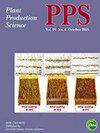Synergistic and sustainable impact of reducing nitrogen fertilizer on growth, yield, and quality of ramie (Boehmeria nivea L.)
IF 1.3
3区 农林科学
Q2 AGRONOMY
引用次数: 1
Abstract
ABSTRACT Ramie (Boehmeria nivea L.) is China’s unique environmentally friendly cash crop. To protect the environment more strictly and develop sustainably, the planting process will reduce the input of fertilizer (nitrogen fertilizer). The effect of reduced nitrogen fertilizer on the yield and quality of ramie is still under systematic investigation. Taking the fiber variety ‘H5’ as the target, 4 N application rates of 100% (N 390 kg/hm2), 85%, 70%, and 55% were set, with no N application as the control (marked as N100, N85, N70, N55, and CK), to study the effects of N reduction on ramie yield, N uptake and utilization, and soil fertility. The results showed that the total production of ramie first harvest raw fiber and nitrogen accumulation showed a trend of first rising and then falling with the decrease of nitrogen application, the output of secondary and tertiary harvest ramie decreased with the reduction of nitrogen application, and the total production of N85 treatment was the highest. Compared with N100, N70 and N85 can improve n utilization, N agronomic utilization, N partial productivity, and N harvest index. Nitrogen reduction can reduce the content of soil organic matter, available phosphorus, and available potassium in ramie, and the difference between N85 and N100 is not significant. Nitrogen fertilizer application can be reduced by 15% in ramie production. Graphical abstract减施氮肥对苎麻生长、产量和品质的协同和可持续影响
摘要苎麻(Boehmeria nivea L.)是中国特有的环保经济作物。为了更严格地保护环境和可持续发展,种植过程将减少肥料(氮肥)的投入。还原氮肥对苎麻产量和品质的影响仍在系统研究中。以纤维品种‘H5’为目标,设定4个施氮率分别为100%(N 390 kg/hm2)、85%、70%和55%,以不施氮为对照(标记为N100、N85、N70、N55和CK),研究减氮对苎麻产量、氮吸收利用和土壤肥力的影响。结果表明,随着施氮量的减少,初采苎麻纤维总产量和氮积累呈现先升后降的趋势,二、三采苎麻产量随施氮量减少而下降,N85处理的总产量最高。与N100相比,N70和N85能提高氮素利用率、农艺利用率、氮偏生产力和氮收获指数。氮还原可降低苎麻土壤有机质、有效磷和有效钾的含量,N85和N100的差异不显著。苎麻生产中氮肥施用量可减少15%。图形摘要
本文章由计算机程序翻译,如有差异,请以英文原文为准。
求助全文
约1分钟内获得全文
求助全文
来源期刊

Plant Production Science
农林科学-农艺学
CiteScore
5.10
自引率
4.00%
发文量
27
审稿时长
>36 weeks
期刊介绍:
Plant Production Science publishes original research reports on field crops and resource plants, their production and related subjects, covering a wide range of sciences; physiology, biotechnology, morphology, ecology, cropping system, production technology and post harvest management. Studies on plant production with special attention to resource management and the environment are also welcome. Field surveys on cropping or farming system are also accepted. Articles with a background in other research areas such as soil science, meteorology, biometry, product process and plant protection will be accepted as long as they are significantly related to plant production.
 求助内容:
求助内容: 应助结果提醒方式:
应助结果提醒方式:


